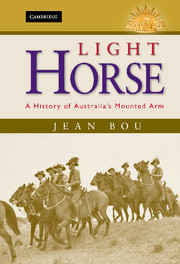Book contents
- Frontmatter
- CONTENTS
- List of maps
- ACKNOWLEDGEMENTS
- AUTHOR'S NOTE
- ABBREVIATIONS
- INTRODUCTION
- CHAPTER 1 ANCESTORS
- CHAPTER 2 TOUGH LESSONS
- CHAPTER 3 THE HUTTON ERA
- CHAPTER 4 UNFULFILLED PROMISE
- CHAPTER 5 THE LIGHT-HORSEMEN 1
- CHAPTER 6 MOUNTED RIFLES
- 7 CAVALRY
- CHAPTER 8 THE LIGHT-HORSEMEN 2
- CHAPTER 9 THE FINAL YEARS
- CONCLUSION
- EPILOGUE
- APPENDIX THE ‘BEERSHEBA CHARGE PHOTO’
- Notes
- BIBLIOGRAPHY
- INDEX
- Frontmatter
- CONTENTS
- List of maps
- ACKNOWLEDGEMENTS
- AUTHOR'S NOTE
- ABBREVIATIONS
- INTRODUCTION
- CHAPTER 1 ANCESTORS
- CHAPTER 2 TOUGH LESSONS
- CHAPTER 3 THE HUTTON ERA
- CHAPTER 4 UNFULFILLED PROMISE
- CHAPTER 5 THE LIGHT-HORSEMEN 1
- CHAPTER 6 MOUNTED RIFLES
- 7 CAVALRY
- CHAPTER 8 THE LIGHT-HORSEMEN 2
- CHAPTER 9 THE FINAL YEARS
- CONCLUSION
- EPILOGUE
- APPENDIX THE ‘BEERSHEBA CHARGE PHOTO’
- Notes
- BIBLIOGRAPHY
- INDEX
Summary
Although the last horse-mounted units were disbanded in 1944, Australia continues to maintain units that carry the title of light horse regiments. Like the cavalry units of so many armies around the world, they are now organised as units of the nation's armoured forces. With the re-establishment of a peacetime army in 1948 nine units of the Australian Armoured Corps (later granted a Royal prefix; the RAAC) were created in the part-time (militia) Citizen Military Forces that drew on a pre-war light horse or motor regiment heritage. By blending new roles with old numbers and titles, new units such as the 1st Armoured Regiment (New South Wales Lancers) and the 3rd/19th Armoured Car Regiment (South Australian Mounted Rifles) were raised. Reforms, renamings and reorganisations, and inevitably periodic army reductions, have resulted in numerous changes over the years. In the late 1950s, for example, the 2nd/14th Queensland Mounted Infantry was organised as an anti-tank regiment, and during the same period the 8th/13th Victorian Mounted Rifles was a medium tank regiment. By the 1960s most units that had survived were organised as cavalry or armoured personnel carrier regiments. In the twenty-first century most have again been reorganised and lost their armoured vehicles in favour of specially equipped four-wheel-drive Land Rovers to fulfil a new ‘light cavalry’ role.
Of the armoured units raised as part of the Australian Regular Army after the Second World War none were created that overtly drew on pre-war light horse traditions or titles, although periodic efforts have been made to link these regiments more clearly to the old light horse; the general adoption of light horse colour patches and emu plumes by the RAAC in the 1990s being some of the more recent examples.
- Type
- Chapter
- Information
- Light HorseA History of Australia's Mounted Arm, pp. 262 - 263Publisher: Cambridge University PressPrint publication year: 2009

